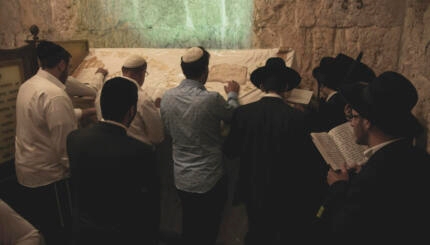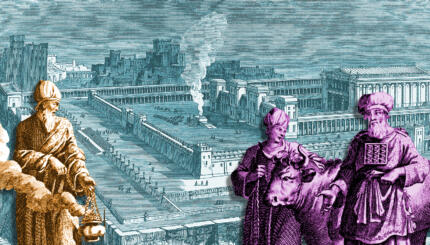The following article is reprinted with permission from A Historical Atlas of the Jewish People edited by Eli Barnavi and published by Schocken Books.
Messianic agitation was widespread among Spanish Jews even before the expulsion, and it certainly grew stronger in its aftermath. In the sixteenth century, many kabbalists, among them Abraham ben Eliezer ha‑Levi and Solomon Molkho, became obsessed with eschatological themes. With the approach of the year 5335 (1574 of the Christian Era), the Jewish world witnessed a new upsurge of messianic fervor. Some regarded Isaac Luria, the great Safed kabbalist, as the Messiah; while Hayyim Vital, Luria’s disciple, preferred to see himself as the hero of a messianic drama.
Eschatological tension apparently abated somewhat in the first half of the seventeenth century, but in the second half of that century expectations for imminent redemption seemed to reach a new peak. Several historical developments account for this renewed wave of messianism: the intensification of eschatological tension among certain radical Protestant groups in Europe, particularly in Holland and England; the massacres of 1648‑1649 which destroyed hundreds of communities in Poland and the Ukraine; recent memories of Solomon Molkho’s messianic activity; and finally, the diffusion of kabbalist literature which was permeated with calculations for the End of Days.
Shabbetai Zevi
Yet even within this context, the momentous success of Shabbateanism was a remarkable phenomenon. Born in Smyrna (Ismir), Shabbetai Zevi [1626-1676] moved to Jerusalem, then to Gaza where he met with an adept of Lurianic –Nathan Ashkenazi, called Nathan of Gaza. Nathan, receiving a revelation about the messianic role of his companion, became the prophet of the new Messiah.

Help us keep Jewish knowledge accessible to millions of people around the world.
Your donation to My Jewish Learning fuels endless journeys of Jewish discovery. With your help, My Jewish Learning can continue to provide nonstop opportunities for learning, connection and growth.
The terminology he used was derived from Lurianic Kabbalah as well as from concepts of popular Jewish messianism. Although Shabbetai Zevi himself studied other kabbalistic trends and was averse to Lurianic theosophy, this did not affect the enormous success of Nathan’s propaganda. Within a very short time its impact was felt throughout the diaspora in processions of joy, acts of extreme mortification, and innumerable delegations who came to behold the Messiah.
This messianic agitation soon alarmed the Ottoman authorities. Summoned to appear before the sultan, Shabbetai Zevi was given a choice of apostasy or death. To the amazement of all his believers, the Messiah converted to Islam. His prophet Nathan immediately came up with an audacious kabbalist explanation: the Messiah has descended into the depths of the kelippah–the realm of evil–to conquer it from within. And so strong was the aspiration for redemption that neither the apostasy nor the death of Shabbetai Zevi destroyed the belief of his followers.
Among them we may distinguish two radical currents. In Greece the sect of the Doenmeh (Turkish for “converts” or “apostates”) professed Islam in public but adhered to a mixture of traditional and heretical Judaism in secret, believing in the divinity of Shabbetai Zevi and practicing sexual license. This sect survived in Greece till 1924 and then moved to Turkey.
Frankism
In 18th‑century Europe, a last burst of Shabbateanism occurred with the appearance of Jacob Frank, a former disciple of Shabbetai Zevi who came under the influence of radical Shabbatean trends in the Balkans. Frank declared himself to be an incarnation of divinity and the successor of the Messiah from Smyrna. Frankism advocated outward adherence to Catholicism while secretly believing in a nihilistic version of heretical Judaism. Spreading from Poland to central Europe, the influence of the Frankists persisted well into the nineteenth century.
Shabbateanism in its various forms weighed heavily on the Jewish conscience. Its immense success could be attributed partly to the phenomenon of marranism. Communities of Jews who had been forcibly converted and returned to Judaism, without fully assimilating its rigid normative system, were naturally more inclined to accept the antinomian tendencies of Shabbatean messianism.
Another factor was the great social and intellectual mobility which facilitated the rapid transmission of ideas. The general crisis of the mid‑seventeenth century also precipitated a great wave of millenarianism in Europe, and Shabbateanisrn was the Jewish expression of this general outburst.


